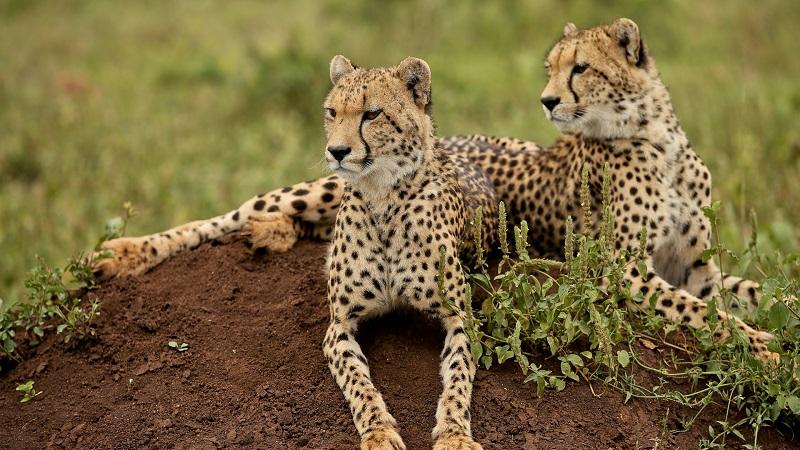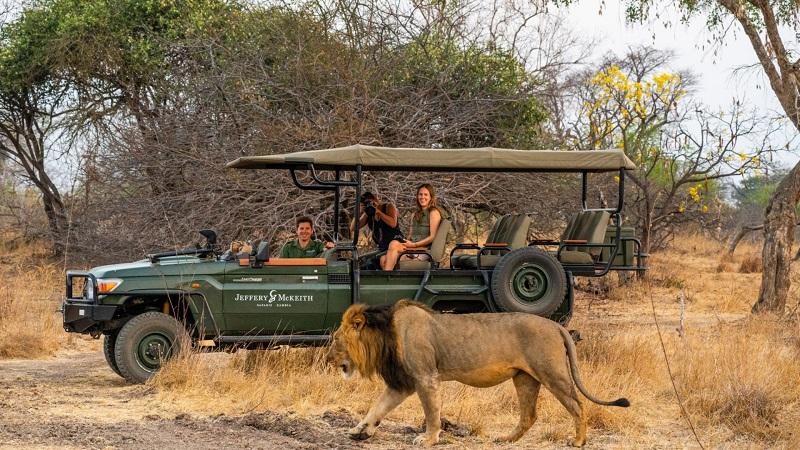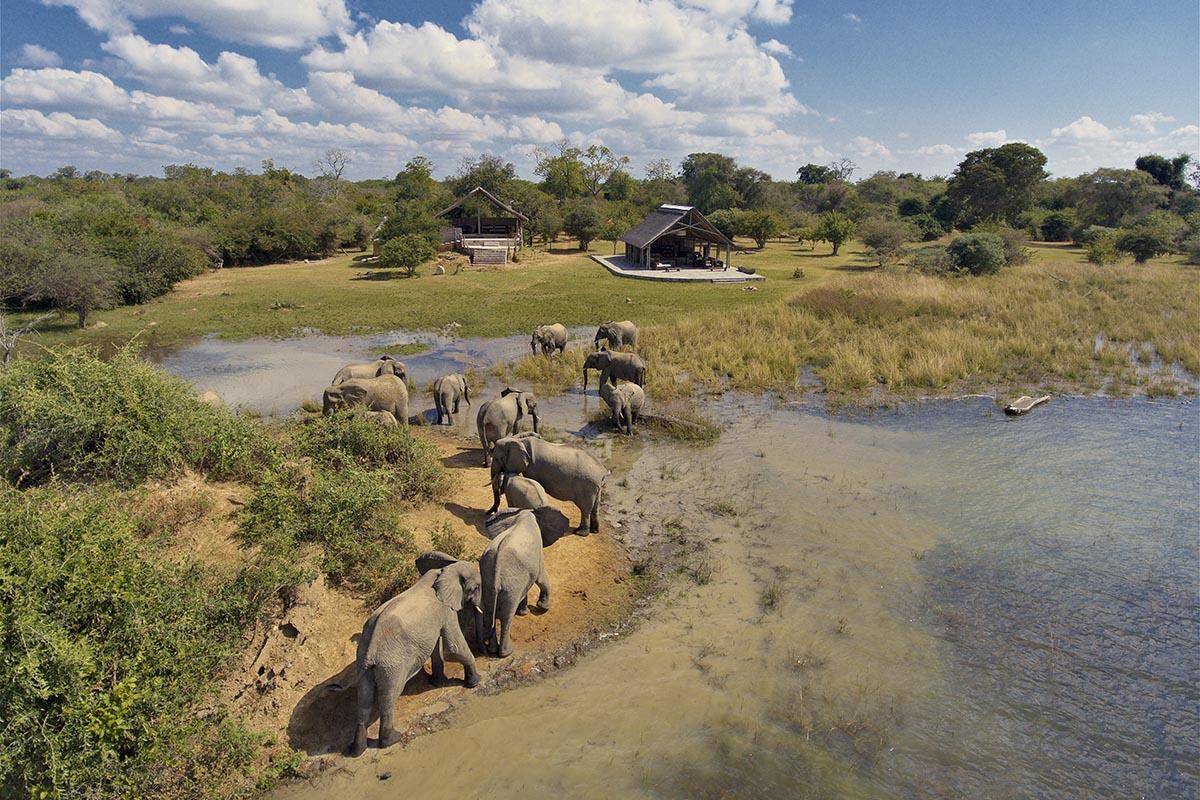As the largest national park in Zambia and one of the oldest in Africa, Kafue National Park covers a vast area of about 22,400 square kilometers. Established in the 1950s, Kafue is famous for its diverse ecosystems, ranging from wetlands and floodplains to dense forests and vast savannahs.
The park is named after the Kafue River, which flows through its heart, providing a crucial water source for the abundant wildlife that calls the park home. Despite its impressive size, Kafue remains one of Zambia’s lesser-known safari destinations, giving visitors a chance to explore its landscapes without the crowds.
Its rich biodiversity includes a wide array of mammals, birds and reptiles making it a true gem for wildlife enthusiasts. Whether it’s boat safaris on the Kafue River, game drives through the plains, or birdwatching in its wetlands, Kafue National Park offers something for every nature lover.
Please Download Our Mobile App here.
Overview of Kafue National Park
Kafue National Park, located in western Zambia, is a place of great contrasts with its landscapes shifting from the swampy Busanga Plains in the north to the miombo woodlands and riverine forests.
The park’s size allows it to support a large variety of species, and it remains relatively untamed and undeveloped compared to other popular African parks. As a result, visitors often find Kafue to be a hidden gem, offering an off-the-beaten-path safari experience with a unique sense of wilderness.
Wildlife in Kafue National Park

Kafue National Park is home to a wide range of wildlife species, making it a haven for safari enthusiasts. The park boasts an impressive diversity of animals, with over 55 mammal species, including the iconic Big Five: lion, elephant, leopard, buffalo and rhino. Although rhinos are rare in the park, the other four members of the Big Five are often seen roaming the park’s vast landscapes.
The Busanga Plains in the northern part of Kafue are particularly famous for their wildlife sightings, especially during the dry season when animals congregate around water sources. This region is known for large herds of herbivores, including buffalo, zebra, and antelope species such as puku, lechwe and waterbuck. These herds, in turn, attract predators like lions, cheetahs and hyenas, making the Busanga Plains an excellent location for witnessing dramatic predator-prey interactions.
Leopards are frequently spotted in Kafue’s woodlands and the park also supports a healthy population of wild dogs, one of Africa’s most endangered carnivores. For those interested in elephants, Kafue offers the opportunity to see these magnificent creatures in significant numbers, particularly in the southern parts of the park.
In addition to the larger mammals, Kafue is home to a variety of smaller animals, including warthogs, baboons and bush pigs. Visitors may also encounter the elusive sitatunga antelope in the park’s swampy regions, as well as the beautiful roan and sable antelopes which are relatively rare in other parts of Africa.
Kafue is also a paradise for birdwatchers, with over 500 bird species recorded in the park. The wetlands and floodplains are particularly rich in birdlife, with species like the wattled crane, African fish eagle and goliath heron commonly seen. The park’s diverse habitats support a wide range of avian life, from waterbirds to raptors and woodland species.
The Best Time to Visit Kafue National Park
The best time to visit Kafue National Park is during the dry season, which runs from May to October. During these months, the weather is cooler and wildlife is easier to spot as animals congregate around water sources, particularly in the Busanga Plains. The dry season is also the best time for game drives and boat safaris on the Kafue River.
The wet season, from November to April brings lush vegetation and abundant birdlife, making it an excellent time for birdwatching. However, some roads may become impassable during this time and certain camps may close, so it’s important to plan accordingly if visiting during the wet months.
Getting to Kafue National Park

Kafue National Park is located about 300 kilometers west of Lusaka, Zambia’s capital. Visitors can reach the park by road, with the journey taking approximately 4 to 6 hours depending on which part of the park is being accessed. A 4×4 vehicle is recommended for navigating the park’s terrain, especially during the rainy season when roads can become muddy.
For those seeking a quicker option, flights are available from Lusaka to various airstrips within the park, including Lufupa and Chunga airstrips. Flying is the most convenient way to reach remote areas of the park, such as the Busanga Plains.
Other Activities in Kafue National Park
In addition to game drives, Kafue National Park offers a range of activities for visitors to enjoy. Boat safaris on the Kafue River provide a unique perspective on the park’s wildlife, with opportunities to see hippos, crocodiles and a variety of waterbirds. Walking safaris are also available, allowing visitors to explore the park’s landscapes on foot and learn about the smaller aspects of the bush from knowledgeable guides.
Fishing is another popular activity in Kafue, with the Kafue River offering excellent opportunities to catch tiger fish, bream and other freshwater species. For bird enthusiasts, the park’s wetlands and floodplains provide exceptional birdwatching opportunities, with a wide variety of species to be spotted.
Park Fees for Kafue National Park

As of 2024, park fees for Kafue National Park are as follows:
- Foreign Visitors (Adults): $25 per person per day
- Foreign Visitors (Children): $15 per person per day
- Zambian Residents (Adults): $20 per person per day
- Zambian Residents (Children): $10 per person per day
Additional fees may apply for guided safaris and other activities.
FAQs: Touring Kafue National Park
Do I Need a Car to Tour the Park?
Yes, having a car is necessary to tour Kafue National Park, especially for game drives. Most visitors opt for guided tours provided by lodges or safari operators.
Are Unguided Walks Allowed in the Park?
No, unguided walks are not permitted in Kafue National Park. Walking safaris must be conducted with a licensed guide for safety reasons.
How Much is a Game Drive in the Park?
Game drives in Kafue National Park typically cost between $50 and $100 per person, depending on the safari operator and duration of the drive.
Conclusion
Kafue National Park is a vast and diverse wilderness that offers visitors a unique and uncrowded safari experience. With its wide variety of wildlife, stunning landscapes and numerous activities, it is an ideal destination for those seeking an authentic African adventure.



